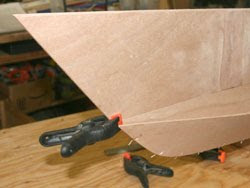You can build these kayaks without a special long table (strongback), but if you have the room, I recommend that you build one. The cost is quite minimal--two sheets of 1/2" CD plywood and three 12' 2x4s. You might also want to build two saw horses for legs or you can put the strongback on top of an existing support (I used my table saw and outfeed table). The ropes and pulleys were intended to make it possible to get the strongback up against the ceiling and out of the way. It didn't turn out to be that useful--once you get started you tend to use the strongback continuously.

The kit comes in an 8' box. The first step is to glue pieces together to make the 17' panels. This was one of two steps in the kit process where the strongback was very helpful. I don't think I would have been quite as confident of the alignment of the individual pieces without a flat surface where I could secure each piece of the panels. I used most anything I could get my hands on for weights on the joints. I also, per the instructions, used small finishing nails to secure the panels once they were aligned. Ouch--I didn't like putting the holes in the panels.
Tip 1: When gluing the panels together, turn them over at least once and look for plywood stamps on the other side. If you start gluing without doing this, you may soak the ink in resin and make it difficult to sand out.
Tip 2: Chamfer the edges of the panels. You'll find that trying to align and hold the sharp edge of the panels exactly matched as you wire is exceedingly difficult. A nice bevel will make the task much easier. You can do this with a file or small hand plane. The angle isn't critical, but you can estimate the half-angle that matches the boat shape just by looking at these photos. CAUTION: the okume has three obvious layers. Chamfer only through two of them. You can chamfer all the way to a sharp edge, if you're careful, but you'll find later that if you get a really tight joint, you can't introduce resin into the seam. So a tight joint (where the outside edges of the two panels meet without any exposed "V") isn't the best idea. From experience, I found that the resin will still go into the joint, but it makes the job much harder.
 The kayak shape comes together quite easily as the panels are attached to the forms. The strongback is helpful, but there is no requirement to specially support the hull to keep it flat or straight. On the other hand, some support is a good idea, if just to keep the stresses low so as not to introduce twist or sag.
The kayak shape comes together quite easily as the panels are attached to the forms. The strongback is helpful, but there is no requirement to specially support the hull to keep it flat or straight. On the other hand, some support is a good idea, if just to keep the stresses low so as not to introduce twist or sag.
 Tip 3: It takes less hot glue than you think to hold the forms in place. Less than an inch in 4 places, on one side, is sufficient. When it comes to removing the forms, you will regret using too much.
Tip 3: It takes less hot glue than you think to hold the forms in place. Less than an inch in 4 places, on one side, is sufficient. When it comes to removing the forms, you will regret using too much.
Tip 4: As you wire the panels together, if you're doing it solo, you'll find the use of helper clamps necessary. This is true to keep the panels aligned at the ends and later to help hold the bow and stern tight.
Tip 5: Make sure you double check the alignment of the joints in the panels. It is very easy to move them 1/8" or so without noticing. OK, now check them again. Now you've wired about half the length, check them again.
With the hull fully wired together, you'll add braces to the tops of the forms and invert the hull in order to glue the seams. In the Tern, the braces ensure that you don't have any twist, so the strongback is the simplest way to give you confidence. Using saw horses that have been leveled is an alternative, but how do you know you haven't moved them slightly? It may be obvious in the above photo that the aft form isn't vertical. This was not obvious until the braces were attached. There's no excuse for this in the tern, since the center of the hull is flat. In the Coho, which has moderate "rocker" in the hull, it's a little more difficult to determine what "vertical" is.

















